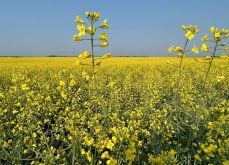Winter wheat officials are considering a new research strategy to fill a potential void in Saskatchewan.
The world-renowned winter wheat program at the University of Saskatchewan’s Crop Development Centre is expected to wind down in the next few years, and there are concerns that the needs of growers in that province won’t be adequately looked after by researchers in the other two prairie provinces.
“It really is responding to the need to have good varieties for Saskatchewan and to have the ability to select in Saskatchewan,” said Rob Graf, a winter wheat breeder at Agriculture Canada’s research centre in Lethbridge.
Read Also

StatCan stands by its model-based crop forecast
Statistics Canada’s model-based production estimates are under scrutiny, but agency says it is confident in the results.
The U of S program is perhaps best known for the cold-hardiness work carried out for many years by Brian Fowler.
Graf said that within five years there will likely be only two winter wheat programs in Western Canada: Lethbridge and the University of Manitoba. That would be down from five a few years ago.
“Potentially that could mean less field testing in Saskatchewan and central Alberta,” he told growers attending the annual meeting of the Saskatchewan Winter Cereals Development Commission held during Crop Production Week in Saskatoon.
At the same time, winter wheat acreage is expected to increase over the next few years for a variety of market and agronomic reasons, making it even more urgent that a solution be found.
“The question is how can the existing programs be strengthened to meet the needs of producers, not only in Saskatchewan, but across Western Canada,” Graf said.
The answer could be to set up a network of research sites across the Prairies, to which researchers from Lethbridge and the U of M would have equal access to test new varieties.
The proposal outlined by Graf would see a main site in each province with a senior research technician, along with one or two satellite locations.
In Saskatchewan, the program would be run out of Saskatoon, with additional research sites at Melfort and Indian Head.
In Alberta, the main location would be Lacombe, with an additional site at Olds.
In Manitoba, Brandon would be the main site, with a satellite station at Neepawa or Minnedosa.
Other stakeholders could possibly conduct agronomic research in concert with those sites, providing a sort of one-stop shopping site for producer field days and grower education.
Graf emphasized that while he favours the proposal, it’s still in the early discussion phase.
“It’s something I’m recommending should take place, but we’ll have to wait and see what happens,” he said in an interview after his presentation.
“It’s really just in its infancy.”
All stakeholders, including Agriculture Canada, the U of M, provincial winter wheat groups and provincial governments, will have to be involved, and funding will have to be found.
“In order for it to fly, all of us are essentially going to have to agree this is the way to go,” said Graf, adding he would like to see test plots in the ground in Saskatchewan this year.
















